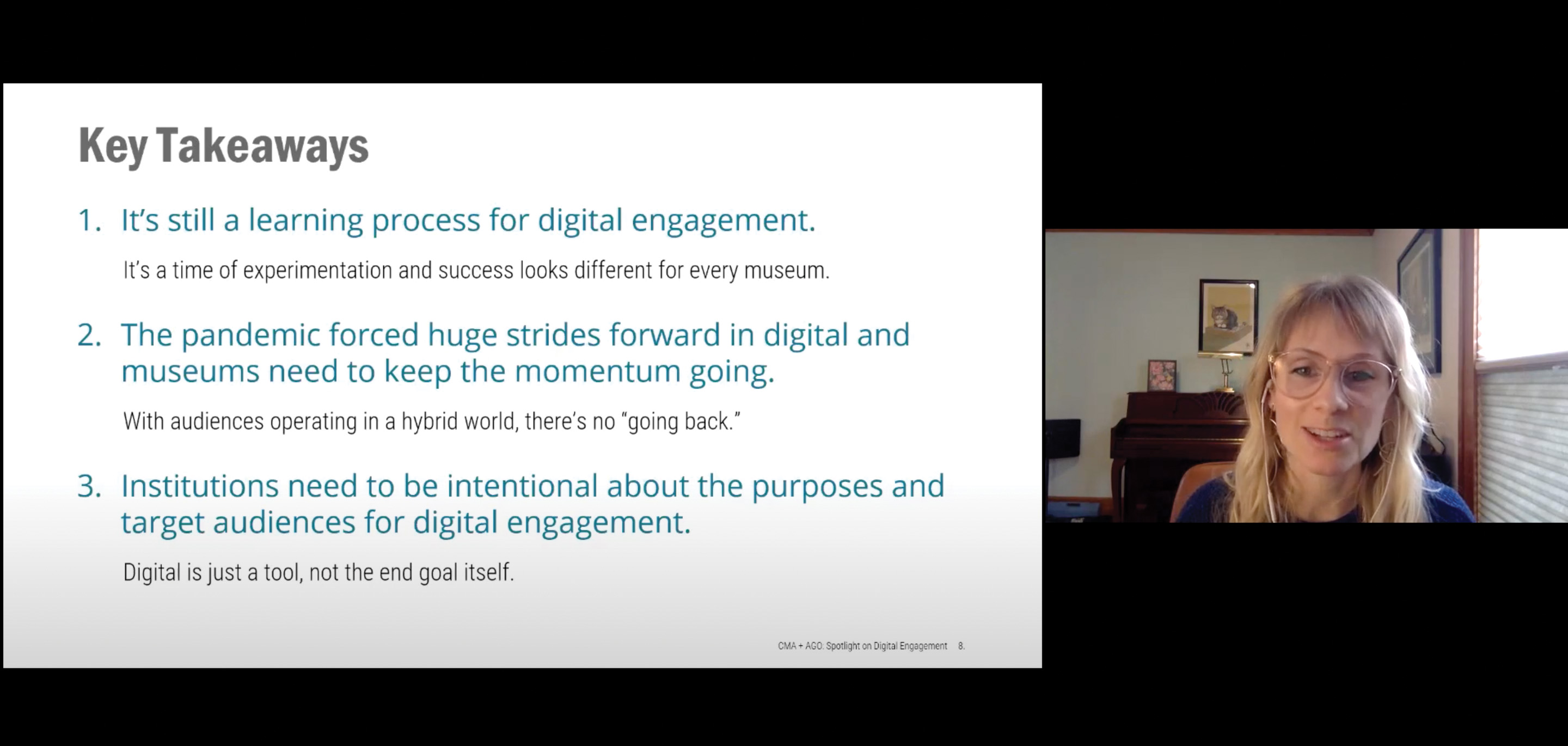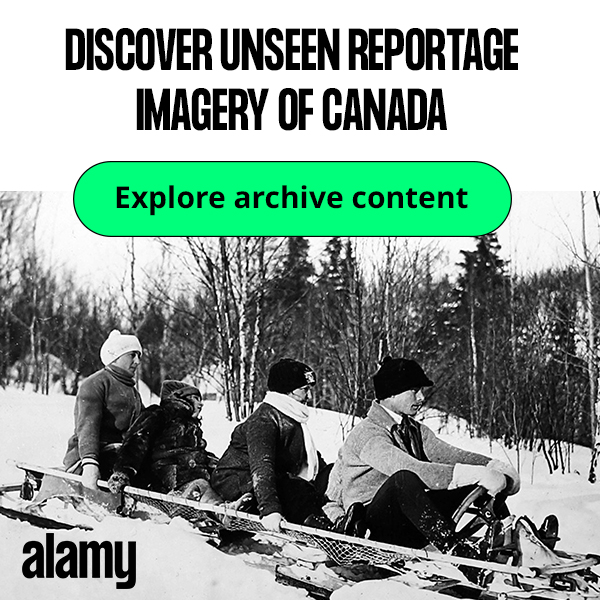
Creating User-Friendly Engagement
Highlights from the “Spotlight on Digital Engagement” webinar
“Museums must dare to speak to digital viewers at the viewers’ own level,” Seema Rao said during the Canadian Museum Association’s webinar on digital engagement.
“I cannot stress this enough: actually meeting people where they are is a success, not a weakness,” said Rao, the Deputy Director and Chief Experience Officer at the Akron Art Museum. “You are not dumbing things down by speaking in a way that people understand you. You’re proving that you’re smart enough to do that.”
It was one of many tips shared during the CMA-hosted 90-minute webinar that was broadcast December 7, 2021. “Spotlight on Digital Engagement” pondered the salient questions, “What works, what doesn’t and how (has) the pandemic changed the game?”
“Where do we see the future going from here ... as we make that transition from an almost pure digital 18-months or so of the pandemic to a hybrid future of both on-site activity as well as maintaining those digital experiences and audiences?” — Mark McKay
This session was presented with the Art Gallery of Ontario, in partnership with Lee Groves Consulting and with support from the Canada Council for the Arts. With Rao on the panel were Anne Lee Groves (Lee Groves Consulting), Mark McKay (Director Digital, Art Gallery of Ontario), Katharine Uhrich (Senior Social Media Manager, Field Museum), Ryan Doherty (Curator, Contemporary Calgary) and Graham Ruttan (Marketing and Communications Officer, Galt Museum & Archives).
McKay summarized the feel of the webinar when he asked how museums can merge the results of the “pandemic digital engagement strategy” as life at museums start to reopen and return to normal.
“Where do we see the future going from here,” McKay asked, “as we make that transition from an almost pure digital 18-months or so of the pandemic to a hybrid future of both on-site activity as well as maintaining those digital experiences and audiences?”
“As human beings, we switch codes. ... we use a different code, ... you write a different thing for the members’ magazine than you do for the granter.” — Seema Rao
Lee Groves said her research found “the pandemic really accelerated digitization and digital became everyone’s job,” which, panelists agreed, is essential for two reasons — to prevent burnout among digital staff during the pandemic, and to underscore the need for digital to be considered from the start on all projects.
“We saw that there are people in digital roles under education, marketing and IT, but in larger and more mature institutions we are seeing that digital roles are becoming less siloed and evolving into more independent, institution-wide resources for digital strategy,” Lee Groves reported.
Digital should not be seen as a mere copy of non-digital content, and it must be approachable and even fun.
“Museums, especially of our size and with our history, can be very intimidating places (and) sometimes people don’t feel welcome,” Uhrich said. “It’s really important that we make science for everyone, and I think sometimes that by letting our guard down and allowing ourselves to have fun as institutions we really open that up to everybody.”
“... it’s really important to define your experiments up front very clearly. It’s not just experimentation for the sake of experimentation.” — Graham Ruttan
She spoke of the Field Museum’s popular social media posts of “Inflatable Sue,” a person (Uhrich’s spouse, in this case) in a blow-up Tyrannosaurus rex costume moving through the museum’s many exhibits.
“We were lucky to have a quarter-million engage-ments on our videos, and also get media pickups on CNN,” she said. “The best part of that, though, was that our audience loved it. … They bring joy and they bring fun and they are an entry point to talk about science and natural history.”
Many museums are demonstrating the value of fun in digital content: The same day as the webinar there was worldwide media coverage of how London’s Natural History Museum dressed its animatronic Tyrannosaurus rex in an ugly Christmas sweater. “There is nothing more funny than a jumper fitted for a dinosaur that has the tiniest arms in the world,” a museum spokesperson told The New York Times. And on January 6, a Canadian Museum of Nature Instagram post had a head-turned, wide-eyed northern saw-whet owl and the words, “That feeling when you just got back from holidays and you have a million emails to answer!” What followed were a few words about the tiny owls, which “only weigh 100 grams — about the same as two golf balls.”

Rao said each social media channel has a different audience and requires a distinct voice, or “code.”
“As human beings, we switch codes. When we go to our mother’s house, or our workplace” we use a different code, she said, and “you write a different thing for the members’ magazine than you do for the granter.”
“We have specific parameters for our voice on each platform, which all go under our umbrella brand voice: energetic, engaging and educational. ... When we enjoy it, it’s obvious, and (viewers) can tell. And that was one of our best lessons we learned.”
“You can take risks and try experimenting, but pause to evaluate and iterate and make improvements. Don’t be afraid to drop things if they are not working.” — Anne Lee Groves
Lee Groves added that once a museum has taken social media to the intermediate stage, “You can take risks and try experimenting, but pause to evaluate and iterate and make improvements. Don’t be afraid to drop things if they are not working.”
Ruttan advised “to not let perfect be the enemy of progress,” while McKay added that “it’s really important to define your experiments up front very clearly. It’s not just experimentation for the sake of experimentation.”
True enough, Uhrich added. “Let’s not just do these things because we know we can do them. Let’s add them because we know there’s an audience desire for it.”
Some practices of the physical museum can be translated to digital. Ruttan said partners in the Blackfoot community have held popular in-person sessions at the Galt about their culture, history and beliefs; and during the pandemic Zoom and such tools were used to broadcast new sessions, sometimes demonstrating skills or products the guests had made.
“This is a personal, lived experience that they are sharing with other people of themselves, of their community, of their family members, and our job is really to just get out of the way.”
“Museums, especially of our size and with our history, can be very intimidating places (and) sometimes people don’t feel welcome.” — Katharine Uhrich
There was also talk of collaboration between museums, as seen in Contemporary Calgary’s Field Trip, a website repository of posts from galleries across Canada (www.fieldtrip.art).
“We might make a video about how to make a puppet, and it gets shared by our peers across the country,” Doherty said. “Once you start linking networks together, it grows exponentially.”
He suggested it as inspiration for moving forward out of the pandemic times. “So many institutions all try to do this on their own; it just seems like an opportune time to work together,” he said. “It could be a great way to keep the momentum going.”
Fundamental to all of this was the understanding that the digital user is essential to the modern museum’s success.
“We might make a video about how to make a puppet, and it gets shared by our peers across the country,” Doherty said. “Once you start linking networks together, it grows exponentially. — Ryan Doherty
“The digital visitor,” Lee Groves said, “is just as important as the in-person visitor in terms of brand recognition and fulfilling your mission. Digital channels are really valuable to have real, live dialogue and connection to the communities that you serve.”
McKay concluded the pandemic has shown that “it’s not just about providing a seamless user journey from before you come to the museum to when you leave. It’s really about making connections and being more accessible as well. You need to really think and view things through this lens of being user friendly to create engagement.” M
Visitor centered and Digitally enabled: Lessons Learned for Museum Audience Engagement During COVID, the report from the AGO and Lee Groves Consulting on the research presented at the webinar is now available. Should you care to watch the entire webinar, click here or visit the CMA’s Youtube channel to access the recordings.
